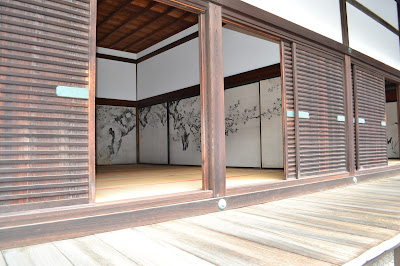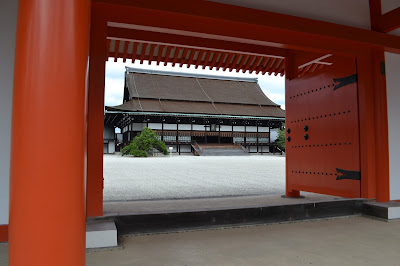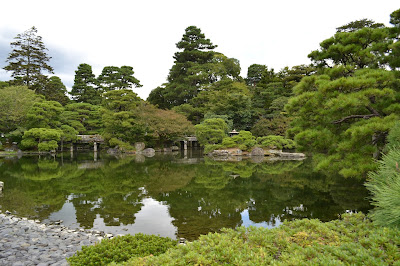October 9, 2014
Part Three of JTB Tour 1
Steeped in culture, the beloved Kyoto was Japan's capital for over 1,000 years. The Kyoto Imperial Palace was the residence of the Imperial family until the capital was moved to Tokyo in 1869. I feel so fortunate to have visited this historic site.
 |
| Behind me is the iconic Shishinden, the ceremonial hall of the Kyoto Imperial Palace. |
 |
| Alan in front of the Oikeniwa Garden's tranquil pond with the Keyakibashi Bridge in the background. |
Located in Gyoen park, the Kyoto Imperial Palace grounds are enclosed by a massive wall. The entire area, which spans approximately 27 acres, is filled with magnificent structures that display Japan's architectural styles and cultural heritage.
 |
| Sheishomon Gate, the main entrance gate |
Once again, I was glad that we booked this tour through JTB USA. They took care of securing the required visitor's permits. Otherwise, we would have had to apply for entry and risk not getting permission on that same day.
Before entering the palace grounds, our JTB tour guide asked the group to form a line with rows of four people. For a moment, I felt as though I was in the military. I glanced at the roofed perimeter wall. It seemed to go on forever.
 |
| The Kyoto Imperial Palace is surrounded by a massive roofed earthen wall. |
I couldn't help notice how spotless it was here. I wish the rest of the world would adopt the Japanese way of keeping surroundings perfectly clean.
 |
| The Okurumayose entrance used by official visitors granted permission to enter the Palace precincts. |
The tour guide led us to the Shodaibunoma building. It was used as a waiting area by dignitaries paying official visits to the Palace. The dignitaries were ushered into three separate ante rooms depending on their rank. The rooms are arranged from highest rank (east) to lowest (west).
Each room is easily identified by the paintings on the sliding panels or fusuma:
1. Highest ranked room = Toranoma (Tiger Room)
2. Second highest ranked room = Tsurunoma (Crane Room)
3. Third highest ranked room = Sakuranoma (Cherry Room); also called the Shodaibunoma
 |
| The separate waiting rooms of the Shodaibunoma |
 |
| The Cherry Room, the third highest ranked room. |
 |
| The second highest ranked room is the Crane Room with cranes depicted on the sliding doors. |
The most commanding structure is the Shishinden. As the Hall for State Ceremonies, it is where they held important ceremonies such as the Emperor's coronation. It is fronted by a pristine garden of white gravel.
 |
| Shishinden, the main building, with a courtyard laid with white gravel |
 |
| View from another entrance into the Shishinden |
This ceremonial hall is a one-story wooden building with a roof made of hiwada or layers of cypress bark. Our tour guide explained that it takes several cypress strips (did she say a thousand?) to create just one square meter of hiwada roof.
The large and ornate gates were also eye-catching. This one is adorned with a distinctive detail: the chrysanthemum seal, a crest used by the Japanese Imperial family. Can you find it in this photo?
 |
| Just one of the tremendous gates of the palace. This is the Kenreimon Gate. |
 |
| The Shunkoden or Sacred Mirror Hall |
Another favorite scenic spot is the strolling garden called Oikeniwa Garden. It features the beautiful Keyakibashi Bridge across a serene pond. This garden is absolutely stunning!
 |
| The Keyakibashi Bridge that stretches across the pond of the strolling garden. |
 |
| The breathtaking pond of Oikeniwa Garden features an artificial shoreline. |
And finally, we marveled at the Otsunegoten, the largest building here. It has 15 rooms and became the main residence of the emperors from the 16th century until the capital was transferred to Tokyo.
 |
| The impressive Otsunegoten |
 |
| A close look at the painted sliding doors inside one of the Otsunegoten rooms. |
At the end of the tour, we were each handed a paper amulet -- a slip of paper inscribed with Japanese characters representing luck. "These are only good for one year," our tour guide teased. "To renew, you must come back for another visit."
Continued from Golden Reflections (Kinkaku-ji Temple).




No comments:
Post a Comment